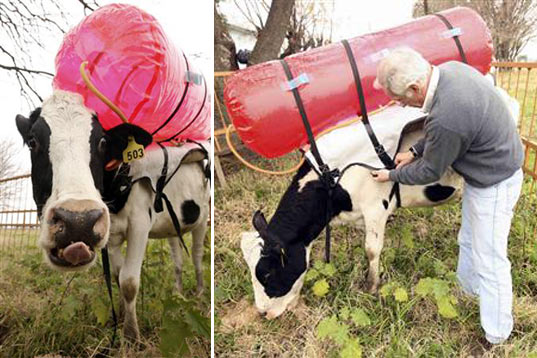Cows are notorious for the amount of methane they produce. Methane is a powerful greenhouse gas (GHG), but just how much do cows actually give off and how does this compare to other methane emission sources? This post tries to give an overview of all things methane and cows..
Where does the methane come from?
The plant diet of cows and other ruminants is high in cellulose, which cannot be digested by the ruminant itself. However, ruminants have a symbiotic relationship with colonies of microorganisms, called methanogens, which live in their gut and break down the cellulose into carbohydrates.. These carbohydrates provide both the microbial community and the ruminant with an energy source. Methane is produced as a by-product of this process.
A common misconception is that the cow’s rear end emits methane, however the vast majority is released orally. Researched carried out by Grainger et al. in 2007 found that 92-98 % was emitted orally (I won’t go into detail about how they found that out!). It is also wrong to think that all bovines emit the same amount of methane but I will go into this in more detail later on in the post.
Global Bovine Emissions
Global emissions of methane were estimated to be between 76 – 92 Tg per year (1 Tg = 1 million metric tonnes). This is roughly equal to ~10-15 % of global methane emissions, which in turn is ~15 % of global GHG emissions. Methane is a more potent GHG than CO2, which means that gram for gram methane warms the atmosphere more than CO2. Methane also has a much shorter lifetime in the atmosphere compared to CO2 (~10 years compared to 100s of years) which will produce more rapid impacts on the global climate. This also means that any reductions in methane emissions will see a faster decrease in atmospheric concentrations than compared to CO2.
Dairy vs. Beef (and some other animals)
The table and figure below compares farmed animals in the UK and their contribution to methane emissions per animal per year in kilograms. A dairy cow emits over twice the amount of methane than a beef cow and is by far the highest contributor of all the animals studied. There are also more dairy cows in the UK than beef cattle (1.81 million compared to 1.66 million). All data found from the UK GHG Inventory report 1990-2012. Other research has shown that cows emit methane at regular times of the day, specifically during feeding and milking. Although these figures do not take into account farming and transport GHG emissions and the actual amount of milk each animal produces, perhaps it would be better to buy goat milk? Although the more preferable metric of Carbon per Litre would allow a more concrete conclusion on this point.
| Kg CH4 | # Dairy Cows | |
| Pigs | 1.5 | 74 |
| Goats | 5 | 22 |
| Sheep | 8 | 14 |
| Beef | 50.5 | 2 |
| Dairy | 110.7 | 1 |
Future Bovine Emissions
Future methane emissions are almost certainly expected to increase due to global food demand increasing from population growth. Developed nations also consume more meat, developing nations are thus expected to increase their meat consumption in future years.
Methods to reduce methane emissions from cows are summarised in the table below (taken from Reay’s book Methane and Climate Change). These have been classified into short term (available now), medium term (available in ten years) and long term (not commercially available for at least another ten years). Many of these suggestions have been disputed as they are not economically viable, especially in developing nations.
| Short Term | Medium Term | Long Term |
| Reduce animal numbers | Rumen Modifiers | Targeted manipulation of rumen ecosystem |
| Increase productivity per animal | Select plants that produce lower methane yield by the animals | Breed animals with low methane yield |
| Manipulate diet | ||
| Rumen Modifiers |
An alternate pathway would be to try and capture emissions from cows. A dairy cow can produce up to 400 litres of methane per day! When burned, this is enough energy to power a small fridge for a day. Some scientists have harnessed methane emitted from cows in backpacks (see photo and video below) however scaling this up to all 10 million cows (this includes all calves, young bulls etc in the UK alone) could be problematic!

Methane backpack. Image sourced from here: http://inhabitat.com/spiffy-backpack-traps-bovine-gas/
Click for the video: “Backpacks measure cows’ methane” (BBC News)
If you have any questions concerning this post please ask in the comments below!

